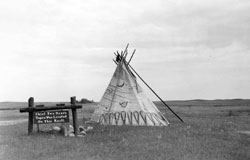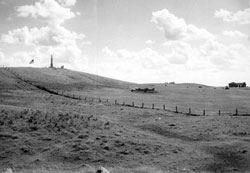We’ve launched a new web portal! Visit findhistory.nd.gov to search our collections.
Due to a road closure, the Killdeer Mountain Battlefield State Historic Site is temporarily closed.
The morning of September 3, 1863, Major Albert E. House, a Battalion Commander of the Sixth Iowa Cavalry, led a scouting party in search of Indians. In the early afternoon, their Métis guide, Frank LaFrambois, discovered a small encampment of Sioux on a small lake near Whitestone Hill. LaFrambois notified Major House, who moved his battalion toward the village. Upon closer reconnaissance, House discovered that the "small" encampment included 300 to 600 lodges. Frank LaFrambois and two soldiers were dispatched to notify General Sully of the discovery and to request reinforcements. While they were gone, the Indians detected the presence of the troops, and some of the villagers prepared to flee, while others prepared to fight.  Major House sent two reconnaissance parties to opposite sides of the tipi encampment to gather tactical information while he waited for the main column to arrive. For nearly three hours, an uneasy standoff continued, during which a delegation of Indian elders approached the soldiers and offered to surrender some of their chiefs. House, however, insisted on total surrender, and negotiations broke down.
Major House sent two reconnaissance parties to opposite sides of the tipi encampment to gather tactical information while he waited for the main column to arrive. For nearly three hours, an uneasy standoff continued, during which a delegation of Indian elders approached the soldiers and offered to surrender some of their chiefs. House, however, insisted on total surrender, and negotiations broke down.
Sully's command was less than a mile away when the Indians saw them coming, and departure preparations became frantic. Tipis were stripped, travois were hastily attached to ponies and dogs, and possessions and small children were strapped to the travois. Masses of Indians began streaming east, down a ravine that opened into a shallow mouth at the rear of the village. It was nearly sunset when Sully's troops reached the scouting party.
As Sully's main column advanced toward the village, it became apparent that the Indians were escaping. Sully ordered Colonel Robert W. Furnas, commanding the Second Nebraska Cavalry, forward at full speed to cut off the Indians' retreat. Stopping briefly to instruct Major House to circle around to the left (north and east), Furnas directed his men around to the right (south), hoping to encircle the village. Seeing that Whitestone Hill blocked escape to the south, Sully sent Colonel David S. Wilson, with part of the Sixth Iowa, to the north side of the village.
General Sully, with one company of the Seventh Iowa Cavalry, two companies of the Sixth Iowa Cavalry, and the artillery battery, charged toward the center of the village. As they passed through the village, they captured a number of prisoners, who were left behind under guard. Sully and his troops climbed to the top of Whitestone Hill to  direct the rest of the battle and to offer artillery support, if needed by the soldiers on the flats below.
direct the rest of the battle and to offer artillery support, if needed by the soldiers on the flats below.
Although the Indians scattered in as many directions as possible, most tried to escape down the ravine. As the Indians came to a saucer-like broadening of the ravine about one-half mile from the village, they began to gather in a large throng. There they were surrounded by Colonel Furna's cavalry, Major House's battalion, and Colonel Wilson's Sixth Iowa troops.
Fearing that the Indians might escape in the impending darkness, Furnas ordered his men to dismount and advance toward the ravine on foot. When his men were within a few hundred yards, he ordered them to begin firing. The other troops followed his lead, dismounted, and closed in on the Indians. Only Wilson's men remained mounted, and, as the attack continued, their horses became wild and unmanageable. The Indians, noticing this weakness in the north firing line, suddenly charged in that direction. Many were able to escape the deadly ravine.
As darkness deepened, Colonel Furnas supsected that bullets from the other units were hitting his lines. He withdrew his troops to higher ground surrounding the ravine. As Furnas and his men withdrew, the other units also broke off the engagement and spent the night on the hilltops overlooking the battlefield.
Address:
7310 86th Street SE
Kulm, ND 58456
Get Directions
Hours:
Open year round.
Contact Whitestone Hill:
phone: 701.328.3508
Contact SHSND:
phone: 701.328.2666
email: history@nd.gov